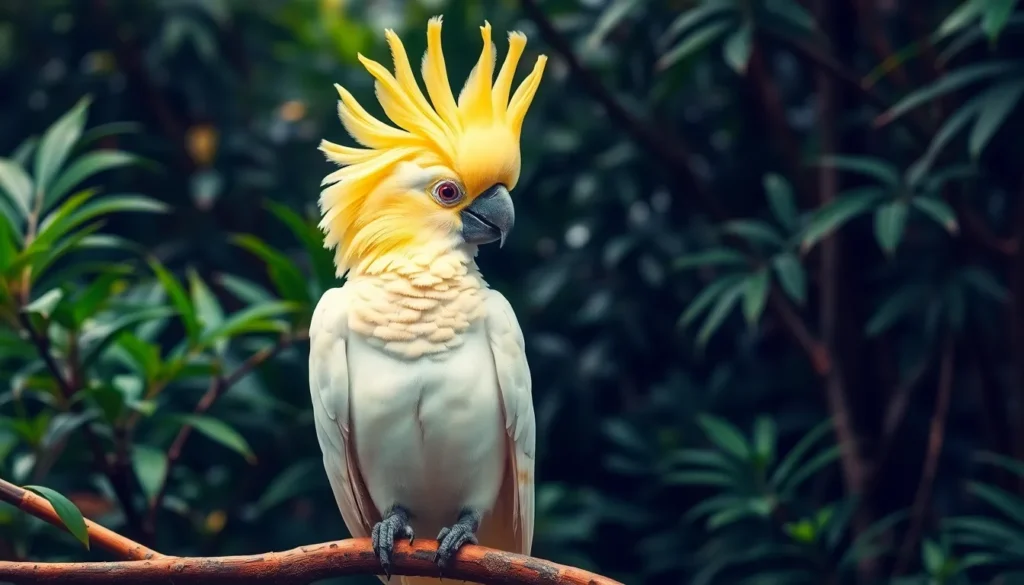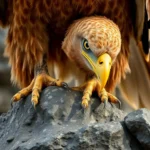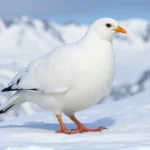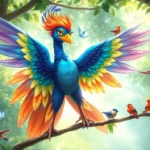When we think of intelligent and charismatic birds, cockatoos (or kakatua birds) immediately capture our attention with their stunning crests and playful personalities. These remarkable parrots have enchanted bird enthusiasts worldwide for centuries, earning their place as one of nature’s most captivating creatures.
We’ve discovered that cockatoos aren’t just beautiful – they’re incredibly smart, social, and surprisingly complex animals that form deep bonds with both their flocks and human companions. From the iconic Sulphur-crested Cockatoo’s dramatic displays to the gentle Major Mitchell’s delicate pink plumage, these birds showcase an incredible diversity that’ll leave you amazed.
Whether you’re considering adding a cockatoo to your family, curious about their wild behaviors, or simply fascinated by avian intelligence, we’re here to guide you through everything you need to know about these extraordinary birds. Let’s explore what makes cockatoos so special and why they’ve become beloved companions across the globe.
What Is a Kakatua Bird?
Kakatua birds represent the Indonesian term for cockatoos, encompassing 21 distinct species within the Cacatuidae family. These magnificent parrots originate from Australia, Indonesia, the Philippines, Papua New Guinea, and the Solomon Islands across diverse ecosystems ranging from tropical rainforests to arid woodlands.
Distinctive crests crown their heads, setting them apart from other parrot families through this iconic feather formation that moves based on emotional states and environmental stimuli. White, black, pink, and yellow plumage variations characterize different kakatua species, with the Sulphur Crested Cockatoo displaying brilliant yellow crest feathers and the Red Tailed Black Cockatoo showcasing deep ebony coloration with vibrant red tail panels.
Physical characteristics of kakatua birds include:
- Body lengths spanning 12 to 24 inches depending on species
- Powerful curved beaks designed for cracking nuts and seeds
- Zygodactyl feet featuring two toes pointing forward and two backward
- Lifespans reaching 60 to 100 years in captivity
- Weight ranges from 300 grams to 1.2 kilograms across species
Complex social structures define kakatua behavior patterns in wild populations. Flocks contain 20 to 100 individuals that communicate through varied vocalizations, body language, and crest positioning signals. Monogamous pair bonding occurs during breeding seasons, with couples remaining together for multiple years while raising offspring in tree cavity nests.
Cognitive abilities place kakatua birds among the most intelligent avian species globally. Research demonstrates their capacity for problem solving, tool use, and vocal mimicry exceeding 100 distinct sounds and human words. The Goffin’s Cockatoo exhibits particular prowess in puzzle solving tasks, manipulating complex mechanisms to access food rewards in laboratory settings.
Physical Characteristics of Kakatua Birds

Kakatua birds showcase remarkable physical diversity across their 21 species, with distinctive features that make them instantly recognizable among parrots. Their anatomical characteristics reflect millions of years of evolution, creating birds perfectly adapted to their native environments.
Size and Weight Variations
The smallest kakatua species, the Cockatiel, measures approximately 12 inches in length and weighs between 2.5 to 3.5 ounces. Medium-sized species like the Galah reach 14 inches and weigh 10 to 14 ounces on average. Large species such as the Palm Cockatoo can grow up to 24 inches tall and weigh between 24 to 42 ounces.
| Species | Length (inches) | Weight (ounces) |
|---|---|---|
| Cockatiel | 12 | 2.5-3.5 |
| Galah | 14 | 10-14 |
| Sulphur-crested | 20 | 17-28 |
| Palm Cockatoo | 24 | 24-42 |
Sexual dimorphism varies among species, with males typically being slightly larger than females in most kakatua varieties. The robust build of these birds supports their active lifestyle and strong flight capabilities across diverse terrains.
Distinctive Crest and Plumage
Crest feathers serve as the most identifying feature of kakatua birds, with each species displaying unique shapes and colors. Sulphur-crested Cockatoos exhibit bright yellow crests that contrast sharply with their white plumage. Major Mitchell’s Cockatoos feature salmon-pink crests with white and red bands that create stunning displays during emotional expressions.
The crest position indicates mood and alertness levels, with raised crests signaling excitement or alarm. Flat crests against the head typically indicate contentment or relaxation. Movement patterns of these feathers help kakatua communicate with flock members and assess environmental threats.
Plumage colors range from pure white in Umbrella Cockatoos to deep black in Red-tailed Black Cockatoos. Pink and gray combinations appear in Galahs, while Cockatiels display orange cheek patches against gray bodies. Feather quality remains consistent throughout their long lifespans when proper nutrition supports molting cycles.
Beak Structure and Color Patterns
Powerful curved beaks distinguish kakatua birds from other parrot families, designed specifically for cracking hard nuts and seeds. The upper mandible hooks over the lower mandible, creating leverage systems capable of generating tremendous crushing force. Beak colors vary from black in larger species to light gray or horn-colored in smaller varieties.
Zygodactyl feet complement the strong beaks, with two toes facing forward and two backward for optimal gripping. These specialized feet enable kakatua to manipulate objects with remarkable dexterity while maintaining secure perches on branches. Claw sharpness and strength support their climbing abilities through dense forest canopies.
Tongue structure features a specialized tip that helps extract seeds and nectar from various food sources. The muscular tongue works in coordination with the beak to process different textures and hardness levels of natural foods. This anatomical combination makes kakatua highly efficient foragers in their native habitats.
Kakatua Bird Species and Varieties
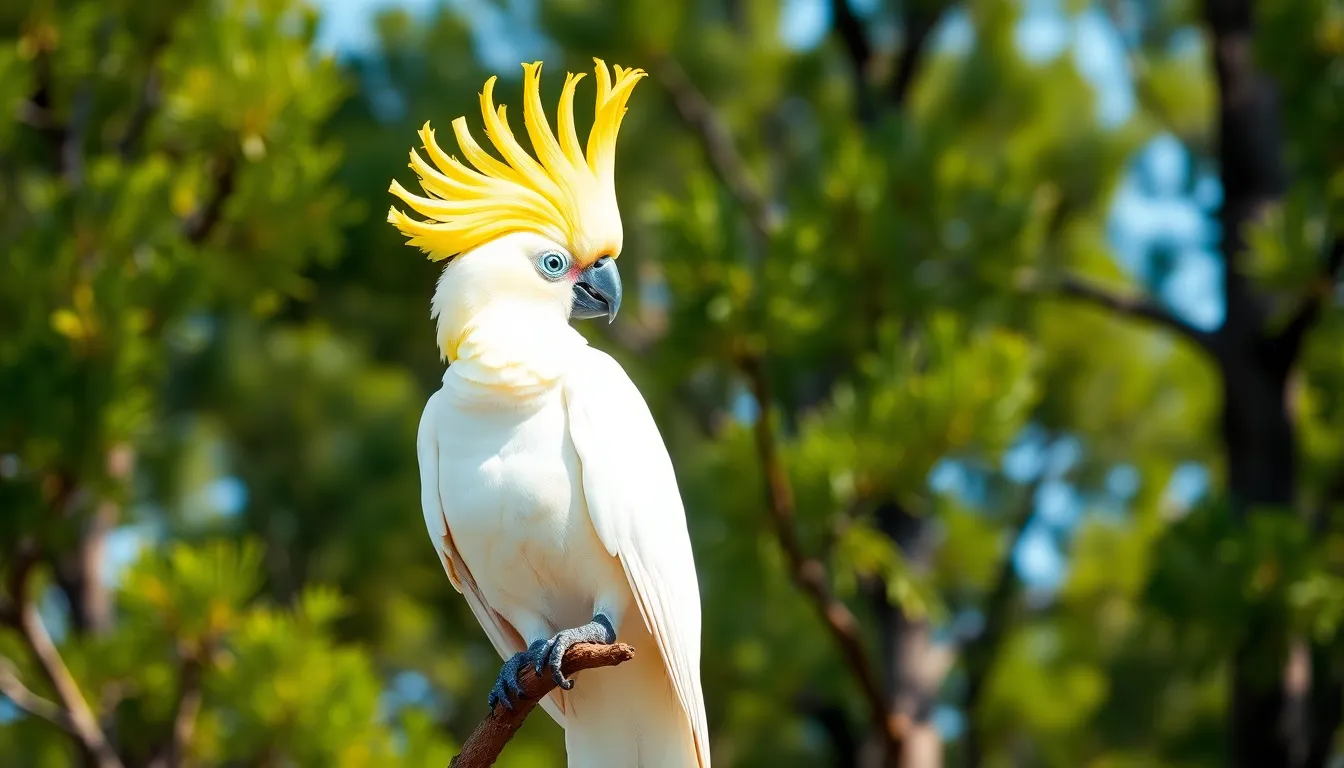
The 21 distinct kakatua species showcase remarkable diversity in size, coloration, and behavioral traits. Each variety has evolved unique characteristics that make them fascinating subjects for bird enthusiasts and researchers alike.
Sulphur-Crested Cockatoo
Sulphur-crested cockatoos stand among the most recognizable kakatua species with their brilliant white plumage and striking yellow crests. These birds measure 18 to 20 inches in length and weigh between 14 to 35 ounces. The distinctive golden yellow feathers on their crests and underwings create dramatic displays during emotional expressions and courtship rituals.
Native to Australia, New Guinea, and some Indonesian islands, sulphur-crested cockatoos demonstrate exceptional intelligence and longevity. They live up to 100 years in captivity and form complex social hierarchies within their flocks. Their powerful black beaks can crack the hardest macadamia nuts, while their loud calls can be heard from distances exceeding 1 mile.
These kakatua varieties exhibit strong problem-solving abilities and can learn to mimic over 100 words and phrases. Wild populations prefer eucalyptus forests and woodland areas where they feed on seeds, nuts, berries, and occasionally insects. Their adaptability has made them successful in urban environments throughout their native range.
Moluccan Cockatoo
Moluccan cockatoos represent the largest white cockatoo species, measuring 20 to 24 inches and weighing up to 35 ounces. Their salmon pink to deep rose colored crests distinguish them from other kakatua varieties, creating spectacular visual displays when fully erected. The subtle peachy undertones on their wing and tail feathers add to their elegant appearance.
Endemic to the Moluccan Islands of Indonesia, these kakatua birds face important conservation challenges due to habitat loss and illegal trade. Wild populations have declined by over 80% in the past three decades, making them vulnerable to extinction. They prefer primary rainforest habitats and rely on exact tree species for nesting cavities.
Moluccan cockatoos possess incredibly strong beaks capable of generating bite forces exceeding 350 pounds per square inch. Their emotional intelligence rivals that of young children, and they form intense bonds with their human companions. These birds require extensive mental stimulation and can develop destructive behaviors without proper enrichment activities.
Umbrella Cockatoo
Umbrella cockatoos earn their name from their distinctive broad, white crests that fan out like opened umbrellas when excited or alarmed. These medium sized kakatua measure 17 to 18 inches in length and weigh between 16 to 26 ounces. Their pure white plumage contrasts beautifully with their dark gray to black beaks and feet.
Originally from the North Moluccas and Bacan islands of Indonesia, umbrella cockatoos have become popular in aviculture worldwide. They demonstrate remarkable vocal abilities and can learn complex melodies and songs. Their natural curiosity drives them to explore their environments thoroughly, often using their feet and beaks to manipulate objects.
These kakatua species require consistent social interaction and mental challenges to prevent behavioral issues. They communicate through a variety of vocalizations including whistles, screams, and soft chattering sounds. Wild umbrella cockatoos travel in flocks of 10 to 60 individuals and can fly distances of 30 miles daily while foraging for food sources.
Natural Habitat and Geographic Distribution
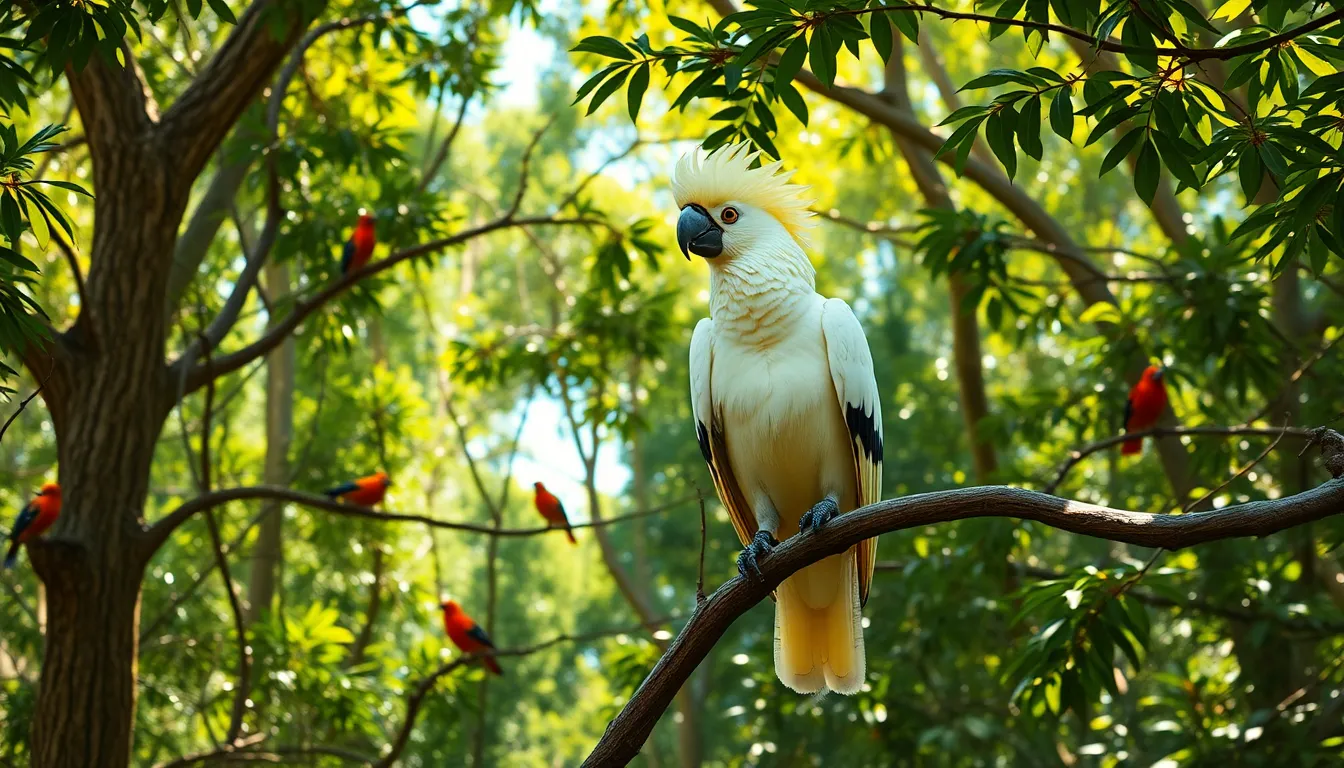
Kakatua birds inhabit diverse ecosystems across the Indo-Pacific region, with their natural range spanning Australia, Indonesia, Philippines, Papua New Guinea, and surrounding islands. Australia hosts the largest concentration of cockatoo species, with 11 of the 21 recognized species calling this continent home.
Primary Distribution Zones
| Region | Number of Species | Notable Species |
|---|---|---|
| Australia | 11 | Sulphur-crested, Galah, Major Mitchell’s |
| Indonesia | 7 | Moluccan, Umbrella, Goffin’s |
| Philippines | 4 | Philippine, Red-vented |
| Papua New Guinea | 5 | Palm, Pesquet’s |
Eastern Australia provides habitat for iconic species like the Sulphur-crested Cockatoo, which thrives in woodlands, urban parks, and agricultural areas from Queensland to Victoria. These adaptable birds occupy elevations from sea level to 2,000 meters, demonstrating remarkable environmental flexibility.
Network Preferences
Tropical rainforests support Indonesia’s endemic kakatua species, including the critically endangered Moluccan Cockatoo in the Maluku Islands. Dense canopy coverage offers nesting sites in tree hollows, while abundant fruit trees provide essential food sources throughout the year.
Eucalyptus woodlands across Australia create ideal conditions for multiple cockatoo species, with hollow-bearing trees serving as crucial nesting sites. Open woodlands with scattered trees allow these birds to forage on seeds while maintaining visibility for predator detection.
Exact Regional Habitats
Northern Australia’s savanna regions house the Palm Cockatoo, which requires exact pandanus palm trees for both food and nesting. This species occupies territories spanning 100 to 200 hectares per pair, making it one of the most territory-dependent kakatua birds.
Indonesian archipelago’s volcanic islands provide unique microclimates for endemic species like the Tanimbar Corella, which exists solely on the Tanimbar Islands. Coastal mangrove forests offer alternative habitats for several species during seasonal migrations.
Elevation and Climate Adaptations
Kakatua species occupy altitudinal ranges from coastal areas to mountainous regions up to 1,500 meters elevation. Highland species like the Long-billed Corella adapt to cooler temperatures and different vegetation patterns compared to their lowland relatives.
Monsoon patterns significantly influence kakatua distribution, with breeding seasons aligning with wet periods when food availability peaks. Dry season movements often concentrate populations near permanent water sources and fruiting trees.
Urban Adaptation Patterns
Suburban environments increasingly support kakatua populations, particularly in Australian cities where species like the Sulphur-crested Cockatoo exploit human-modified landscapes. Urban parks with mature trees provide nesting opportunities, while residential gardens offer supplemental food sources.
Agricultural regions present both opportunities and challenges for kakatua birds, with crop cultivation creating abundant feeding areas while potentially leading to human-wildlife conflicts. Orchard environments particularly attract fruit-eating species during harvest seasons.
Behavioral Traits and Social Structure

Kakatua birds exhibit sophisticated behavioral patterns that reflect their advanced cognitive abilities and strong social bonds. Their complex social dynamics create intricate hierarchies within flocks while maintaining cooperative relationships essential for survival.
Communication and Vocalizations
Kakatua birds demonstrate remarkable vocal diversity through their extensive repertoire of calls, screams, and whistles that serve distinct social functions. These vocalizations range from soft contact calls used between mates to loud alarm screams that can be heard over distances exceeding 1 mile. Each species develops unique vocal signatures, with Sulphur-crested Cockatoos producing over 15 different call types including territorial announcements, food location alerts, and flock coordination signals.
Body language complements their vocal communications through precise crest movements, wing positioning, and head gestures. Raised crests indicate excitement or alertness, while flattened crests against the head signal submission or contentment. Wing spreading displays establish dominance hierarchies within flocks, particularly during feeding competitions or territorial disputes.
Contextual communication varies significantly based on environmental factors and social situations. Morning chorus activities involve synchronized calling sessions where entire flocks participate in coordinated vocalizations lasting 15 to 30 minutes. These sessions strengthen group bonds and establish daily territorial boundaries among neighboring flocks.
Intelligence and Problem-Solving Abilities
Cognitive research demonstrates that kakatua birds possess intelligence levels comparable to 4-year-old human children in exact problem-solving tasks. Goffin’s Cockatoos excel at multi-step puzzle solving, successfully completing sequences requiring up to 8 consecutive actions to obtain food rewards. Laboratory studies document their ability to understand cause-and-effect relationships and plan future actions based on anticipated outcomes.
Tool use behaviors showcase their innovative thinking capabilities across multiple species. Palm Cockatoos create drumsticks from branches to create rhythmic displays during courtship rituals, while some populations modify leaves and twigs for foraging activities. These behaviors indicate cultural transmission within flocks, as younger birds learn techniques through observation and practice.
Memory retention spans extend beyond immediate problem-solving scenarios to include recognition of individual flock members, food source locations, and seasonal migration routes. Captive kakatua birds demonstrate episodic memory by recalling exact events and associating them with particular locations or individuals after intervals exceeding 6 months. Their spatial memory enables precise navigation across territories spanning 50 to 100 square kilometers in wild populations.
Human interaction studies reveal their capacity for emotional intelligence and social learning. Kakatua birds adapt their communication styles when interacting with humans, modifying vocal patterns and behavioral responses based on individual human personalities and interaction histories. This adaptability demonstrates their sophisticated social cognition and emotional processing abilities.
Diet and Feeding Habits in the Wild
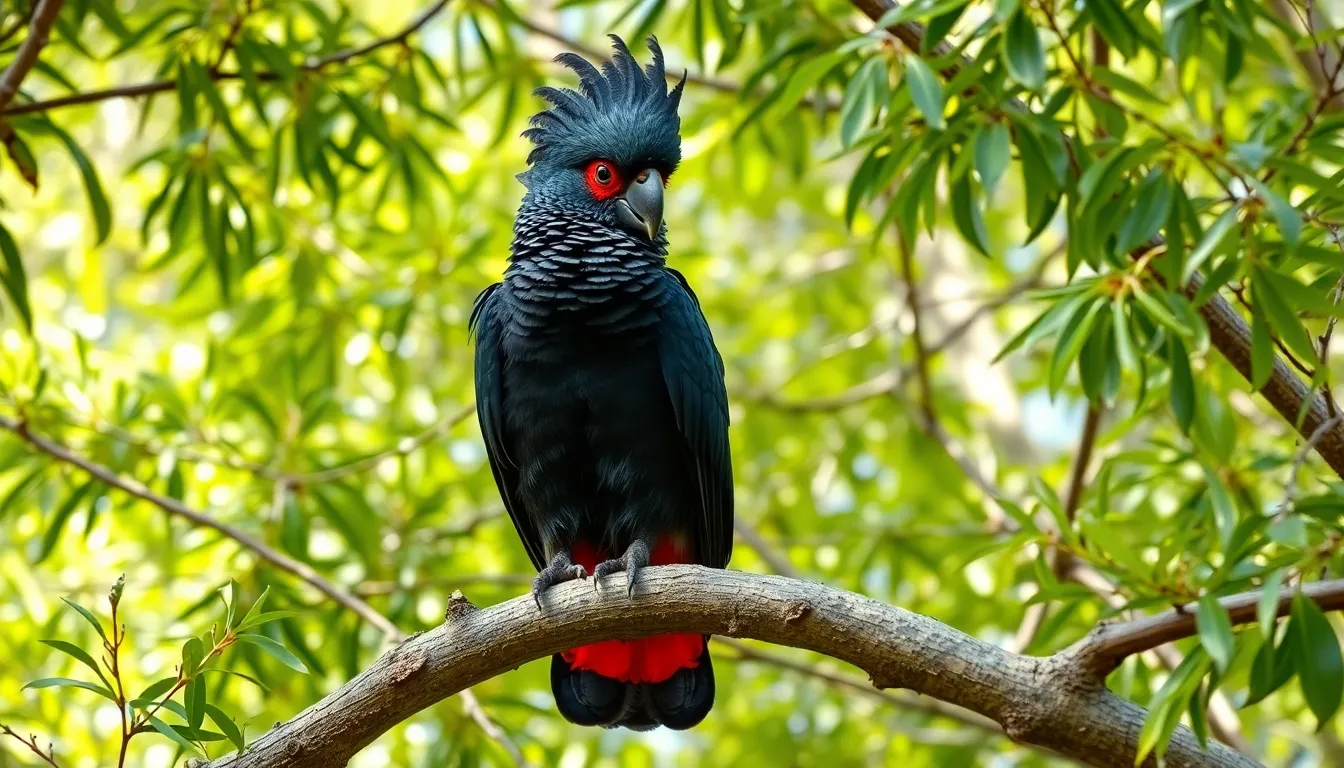
Kakatua birds demonstrate remarkable dietary diversity across their 21 species, adapting their feeding patterns to exploit the abundant resources within their native ecosystems. Seeds form the foundation of their nutrition, with eucalyptus seeds comprising up to 70% of the diet for Australian species like the Sulphur-crested Cockatoo. Nuts from various palm species, pandanus fruits, and acacia seeds provide essential fats and proteins that sustain these intelligent birds throughout their 60 to 100-year lifespans.
Foraging behaviors vary significantly among kakatua species based on their habitat preferences and physical adaptations. Palm Cockatoos use their powerful 3-inch beaks to crack open the hardest nuts, including pandanus palm seeds that other birds cannot access. Galah cockatoos spend 6 to 8 hours daily ground-foraging for grass seeds and small bulbs across Australia’s open woodlands. Major Mitchell’s cockatoos demonstrate selective feeding patterns, choosing seeds with the highest nutritional content during their 4-hour morning foraging sessions.
Seasonal dietary shifts reflect the adaptive intelligence that makes kakatua birds successful across diverse environments. During Australia’s dry season from May to October, cockatoos increase their consumption of stored tree seeds and shift foraging locations to follow ripening cycles. Indonesian species like the Moluccan Cockatoo time their breeding with fruit abundance, consuming up to 40% more calories during the March to August fruiting period. Cockatiels modify their diet composition from 80% seeds in summer to include 30% green vegetation during winter months.
| Species | Primary Foods | Daily Foraging Time | Seasonal Variations |
|---|---|---|---|
| Palm Cockatoo | Pandanus seeds, palm fruits | 3-4 hours | Fruit season focus (Nov-Apr) |
| Sulphur-crested | Eucalyptus seeds, acacia | 5-6 hours | Ground feeding in dry season |
| Galah | Grass seeds, bulbs, shoots | 6-8 hours | Green vegetation in winter |
| Moluccan | Tropical fruits, large seeds | 4-5 hours | Peak feeding during breeding |
Social feeding dynamics enhance foraging efficiency within kakatua flocks of 20 to 100 individuals. Sentinel birds position themselves 15 to 20 feet above feeding groups, using distinct alarm calls to warn of approaching predators while others focus on food acquisition. Cooperative feeding occurs when multiple birds work together to access difficult food sources, with younger birds learning optimal foraging techniques through observation of experienced flock members. Competition within flocks establishes feeding hierarchies, where dominant pairs access premium food sources first during peak feeding periods at dawn and dusk.
Human activity increasingly influences kakatua feeding patterns across their range, creating both opportunities and challenges for wild populations. Agricultural crops provide abundant food sources, with some species consuming up to 25% cultivated grains during harvest seasons from November to February. Urban environments offer consistent water sources and introduced plant species, supporting stable kakatua populations in cities like Perth and Sydney. Conservation efforts focus on maintaining natural food sources, as habitat destruction removes up to 15% of traditional foraging areas annually across key kakatua territories.
Kakatua Birds as Pets: What to Expect
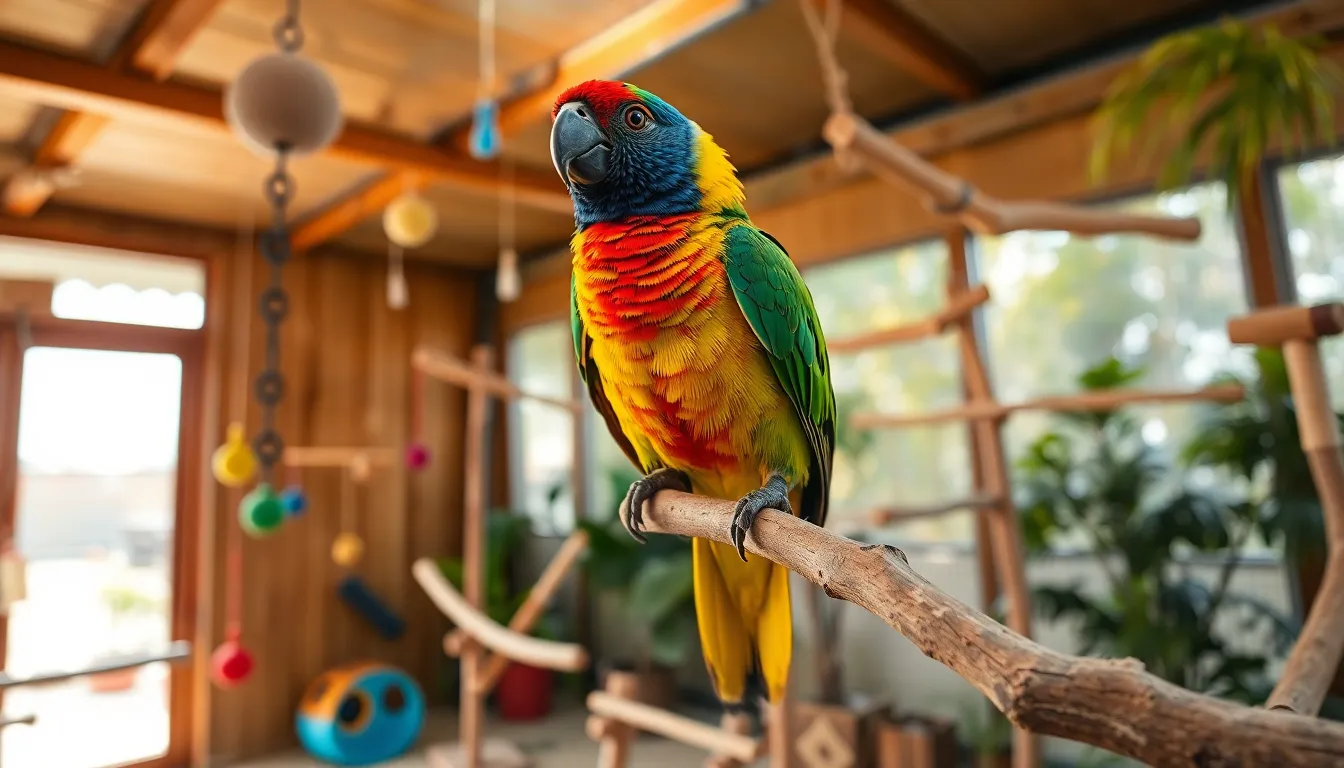
Kakatua birds represent some of the most rewarding yet demanding companions in the avian industry. These intelligent creatures require dedicated commitment and specialized care to thrive in domestic environments.
Care Requirements and Housing Needs
Kakatua birds demand spacious enclosures measuring at least 40 inches wide by 30 inches deep by 60 inches tall for smaller species like cockatiels. Large species including Moluccan and Palm cockatoos require aviaries measuring 8 feet by 4 feet by 8 feet minimum. We recommend powder-coated stainless steel cages with bar spacing of 0.75 to 1 inch for optimal safety.
Daily flight time outside the cage remains essential for physical health and mental stimulation. Kakatua birds require 3 to 4 hours of supervised free flight in bird-proofed rooms. Temperature control maintains their comfort between 65°F and 80°F with humidity levels of 50% to 60%.
Perches crafted from natural hardwood branches provide foot exercise and prevent arthritis. We suggest installing perches of varying diameters from 1 to 3 inches throughout the enclosure. Java wood, manzanita, and apple wood branches offer excellent textures for beak maintenance.
Mental enrichment prevents destructive behaviors common in captive kakatua birds. Rotating puzzle feeders, foraging toys, and wooden blocks keeps their active minds engaged. We replace destroyed toys weekly to maintain interest and safety.
Veterinary care from certified avian veterinarians ensures long-term health. Annual wellness examinations detect early signs of disease, while specialized blood panels monitor organ function. Emergency veterinary services remain crucial given kakatua birds’ tendency to hide illness symptoms.
Training and Socialization Tips
Early socialization during the first 6 months establishes trust and reduces behavioral problems. Kakatua birds form strongest bonds through consistent daily interaction lasting 2 to 3 hours. We recommend starting with basic step-up commands using positive reinforcement techniques.
Clicker training accelerates learning and strengthens the human-bird relationship. Short training sessions of 10 to 15 minutes prevent frustration and maintain engagement. Target training teaches kakatua birds to touch exact objects on command, building foundation skills for complex behaviors.
Vocalization training channels their natural communication abilities into desired behaviors. Kakatua birds learn words and phrases through repetition during their peak learning periods in early morning and evening. We avoid reinforcing excessive screaming by ignoring attention-seeking vocalizations.
Bite pressure training prevents aggressive behaviors before they develop. Teaching gentle beak contact through positive reinforcement creates safer interactions with family members. Redirecting destructive chewing toward appropriate toys protects furniture and household items.
Socialization with multiple family members prevents single-person bonding that leads to aggression toward others. Kakatua birds benefit from structured interaction time with each household member daily. We recommend establishing consistent routines that include feeding, training, and play sessions with different people.
Flight recall training provides safety during supervised free flight periods. Starting indoors with short distances, we gradually increase recall distances as trust and skill develop. Outdoor flight training requires secure harnesses and controlled environments to prevent escape.
Conservation Status and Threats
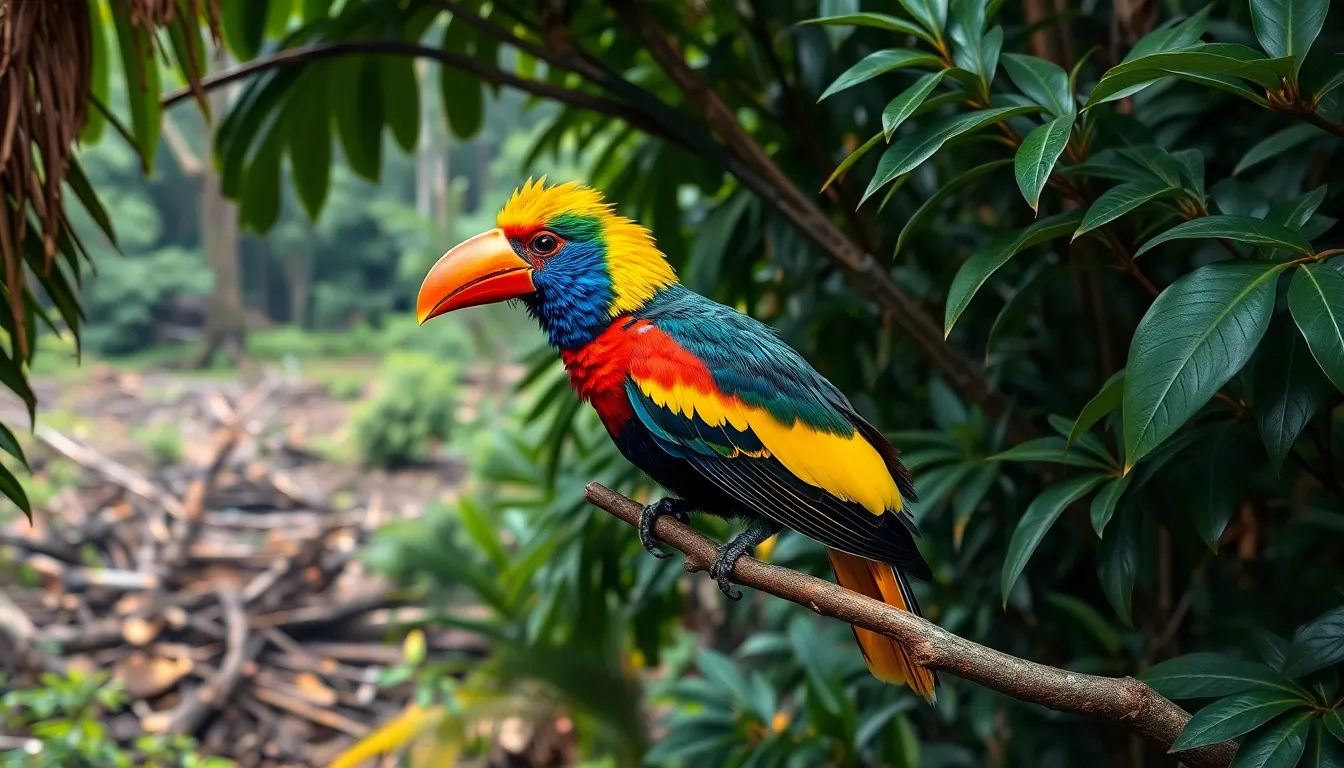
Kakatua birds face varying levels of conservation risk across their 21 species, with habitat destruction representing the most important threat to their populations. The International Union for Conservation of Nature (IUCN) classifies several species as vulnerable or endangered, including the Philippine Cockatoo with fewer than 800 individuals remaining in the wild.
Palm Cockatoos encounter severe population declines throughout their Indonesian and Papua New Guinea ranges, with logging activities destroying their essential nesting trees. Deforestation rates in Indonesia reach 6 million hectares annually, directly impacting kakatua breeding sites and food sources. Agricultural expansion eliminates eucalyptus woodlands and rainforest habitats that sustain these intelligent birds.
Illegal wildlife trade poses another critical threat to kakatua populations, particularly affecting species with striking appearances like the Moluccan and Umbrella Cockatoos. Poachers capture an estimated 5,000 to 10,000 kakatua birds annually from Indonesian forests for the international pet trade. Young birds command higher prices, leading to nest raiding that disrupts breeding cycles and reduces reproductive success rates.
Climate change alters the geographic distribution of kakatua species, forcing them to adapt to shifting weather patterns and food availability. Rising temperatures affect eucalyptus seed production in Australia, creating nutritional stress for species like the Sulphur-crested Cockatoo. Extreme weather events including cyclones and droughts destroy nesting sites and fragment remaining habitats.
Urban development fragments kakatua territories, isolating small populations and reducing genetic diversity among breeding groups. Power lines and communication towers create collision hazards that kill hundreds of birds annually across major cities in Australia and Indonesia. Light pollution disrupts natural roosting patterns and affects nocturnal feeding behaviors in some species.
Conservation efforts focus on habitat protection through national park expansion and reforestation programs across the Indo-Pacific region. Australia maintains protected areas covering 2.3 million hectares of kakatua habitat, while Indonesia establishes new reserves in critical breeding regions. Captive breeding programs operate in 15 countries, maintaining genetic diversity and supporting population recovery initiatives for the most threatened species.
Human activity creates both challenges and opportunities for kakatua conservation, as some species adapt to agricultural environments while others suffer from crop protection measures. Urban kakatua populations increase in certain areas, demonstrating remarkable adaptability even though ongoing habitat pressures. Community education programs engage local populations in protection efforts, reducing capture rates and promoting coexistence between humans and these remarkable birds.
Conclusion
We’ve explored the intriguing area of kakatua birds and discovered why these remarkable creatures captivate bird enthusiasts worldwide. Their unique combination of intelligence emotional depth and stunning beauty makes them truly exceptional companions for those ready to meet their complex needs.
Whether you’re considering welcoming a kakatua into your home or simply admiring them in their natural habitats we hope this guide has provided valuable insights into their extraordinary lives. These birds represent one of nature’s most sophisticated species deserving our respect understanding and protection.
As we face ongoing conservation challenges it’s crucial that we support efforts to preserve kakatua populations for future generations. Their intelligence and social complexity remind us of our responsibility to coexist harmoniously with the natural industry around us.
Frequently Asked Questions
What are kakatua birds?
Kakatua is the Indonesian term for cockatoos, encompassing 21 distinct species within the Cacatuidae family. These intelligent birds originate from Australia, Indonesia, and the Philippines. They’re characterized by distinctive movable crests, powerful curved beaks, and zygodactyl feet. Kakatua birds are known for their remarkable intelligence, social nature, and impressive lifespans of 60-100 years in captivity.
How big do kakatua birds get?
Kakatua birds vary significantly in size across the 21 species. The smallest is the Cockatiel at about 12 inches and 2.5-3.5 ounces, while the largest is the Palm Cockatoo, reaching 24 inches and up to 42 ounces. Most species range between 12-24 inches in body length. Males are generally larger than females in most species.
Where do kakatua birds live in the wild?
Kakatua birds inhabit diverse ecosystems across the Indo-Pacific region. Australia hosts the largest concentration with 11 species, while Indonesia has 7, and the Philippines and Papua New Guinea have 4-5 species respectively. They thrive in various environments from tropical rainforests to eucalyptus woodlands, demonstrating remarkable adaptability to different climates and terrains.
What do kakatua birds eat?
Kakatua birds have diverse diets primarily consisting of seeds, particularly eucalyptus seeds. They also consume nuts, fruits, flowers, and insects depending on seasonal availability. Their powerful curved beaks are designed for cracking hard nuts and seeds. Social feeding dynamics enhance foraging efficiency, with flock members cooperating and establishing feeding hierarchies within their natural habitats.
Are kakatua birds intelligent?
Yes, kakatua birds possess exceptional intelligence comparable to 4-year-old human children. They demonstrate advanced problem-solving skills, tool use, and memory retention. Species like the Goffin’s Cockatoo show remarkable puzzle-solving abilities. They exhibit emotional intelligence, social learning capabilities, and can form deep bonds with humans, making them fascinating subjects for cognitive research and beloved companions.
Can kakatua birds be kept as pets?
Kakatua birds can be kept as pets but require extensive care and commitment. They need spacious enclosures, daily flight time, mental enrichment, and consistent social interaction. Potential owners must provide proper housing, temperature control, and positive reinforcement training. Their 60-100 year lifespan and complex social needs make them suitable only for experienced, dedicated bird enthusiasts.
How do kakatua birds communicate?
Kakatua birds use sophisticated communication methods including diverse vocalizations for alarm calls, mating signals, and social interactions. Their distinctive crests move in response to emotions and environmental stimuli. Body language such as wing positioning and posturing further enhances communication. They maintain complex social hierarchies within flocks of 20-100 individuals through these various communication channels.
What conservation challenges do kakatua birds face?
Habitat destruction poses the greatest threat to kakatua birds, with several species classified as vulnerable or endangered by the IUCN. Additional challenges include illegal wildlife trade, logging, and climate change. Conservation efforts focus on habitat protection, captive breeding programs, and community education. Urban development and agricultural expansion continue to threaten their traditional foraging areas.

